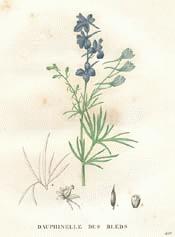
Botanical.com Home Page

|
Royal Knight's-spur
(Consolida regalis printed as
Delphinium consolida)
Click on graphic for larger image
|
Larkspur, Field
Botanical: Delphinium Consolida
Family: N.O. Ranunculacae
---Synonyms---Lark's Heel. Lark's Toe. Lark's Claw. Knight's Spur.
---Part Used---Seed.
---Habitat---Europe.
The Field Larkspur grows wild in cornfields throughout Europe. Though a doubtful native, it is found occasionally in England in considerable quantities in sandy or chalky cornfields, especially in Cambridgeshire.
---Description---It is an annual, with upright, round stems a foot high or more, pubescent and divided into alternate, dividing branches. The leaves are alternate, the lower ones with petioles 1/2 inch long, the upper ones sessile, or nearly so. The plant closely resembles some of the species commonly cultivated in gardens.
The flowers are in short racemes, pink, purple or blue, followed by glabrous follicles containing black, flattened seeds with acute edges and pitted surfaces. The seeds are poisonous, have an acrid and bitter taste, but are inodorous.
The active principle of the plant- Delphinine - is the same as in Stavesacre and is an irritant poison. Children should be warned against putting any part of this plant, or of its garden representatives, into their mouths. The seeds are especially dangerous, and cause vomiting and purging if eaten.
---Medicinal Action and Uses---As in Stavesacre, the part used medicinally is the seed, a tincture of which in like manner acts as a parasiticide and insecticide, being used to destroy lice and nits in the hair. (During the Great War, when the men in the trenches took the trouble to use it, the results were said to be quite successful. - EDITOR.)
The tincture, given in 10-drop doses, gradually increased, is also employed in spasmodic asthma and dropsy.
The expressed juice of the leaves is considered good as an application to bleeding piles, and a conserve made of the flowers was formerly held to be an excellent medicine for children when subject to violent purging.
The juice of the flowers and an infusion of the whole plant was also prescribed against colic.
The expressed juice of the petals with the addition of a little alum makes a good blue ink.
The name Delphinium, from Delphin (a dolphin), was given to this genus because the buds were held to resemble a dolphin. Shakespeare mentions the plant under the name of Lark's Heel.
The name Consolida refers to the plant's power of consolidating wounds.
See STAVESACRE.
[Top]
Common Name Index
A MODERN HERBAL Home Page
Bear in mind "A Modern Herbal" was written with the conventional wisdom of the early 1900's. This should be taken into account as some of the information may now be considered inaccurate, or not in accordance with modern medicine.
© Copyright Protected 1995-2024 Botanical.com
| 
